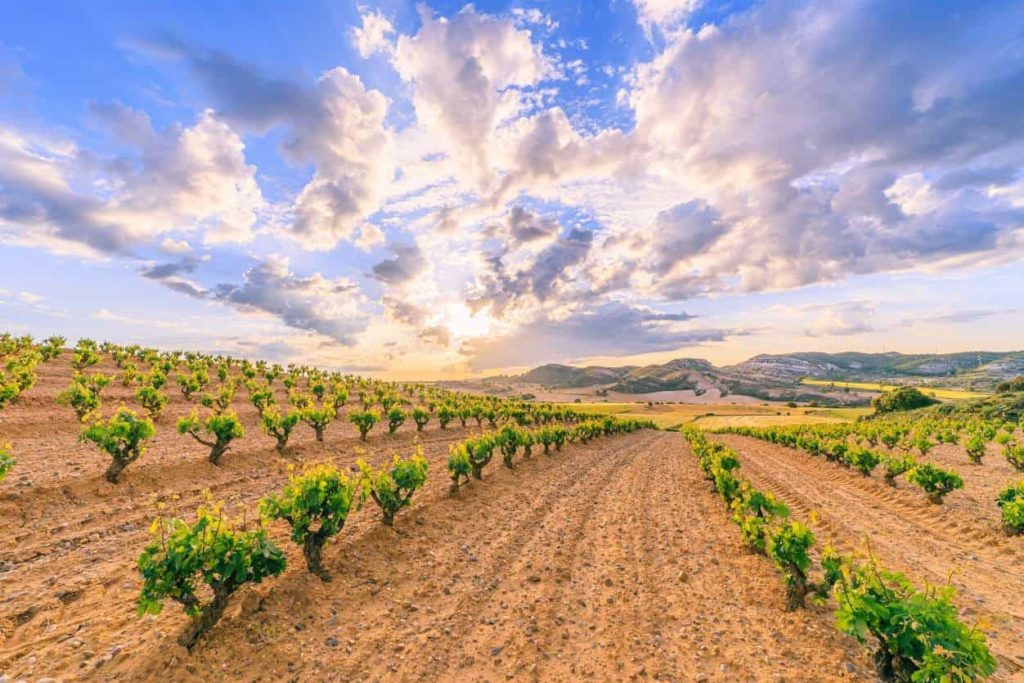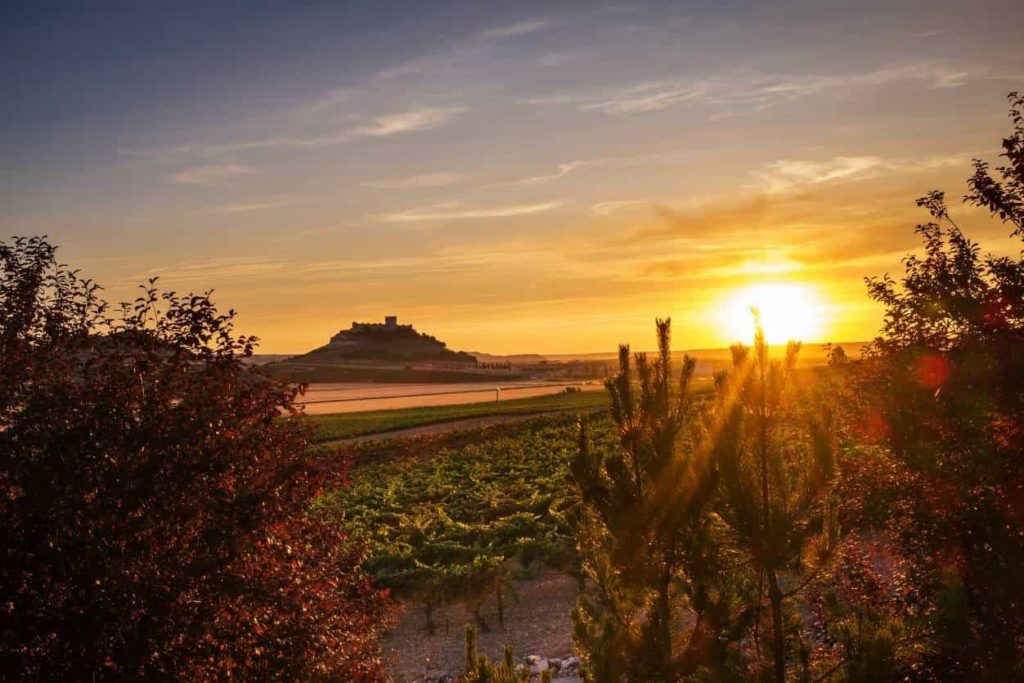
A guide to Spanish wine regions: Ribera del Duero

Ribera del Duero makes its home in the arid expanse of Castilla y León in Northern Spain – a collection of vineyards and cornfields northwest of Madrid borders Portugal and Galicia. The wine region has been pivotal throughout Spain’s rich history; the centralising Catholic monarchs (founders of the Spanish Inquisition) were, in fact, married in the province. The production area, heavily expanded since the 1980s, stretches east from Valladolid to the village of La Olmeda. The vineyards are found on both sides of River Duero, blanketing a valley floor that averages 850 metres above sea level. This vast, high plateau has seen a remarkable transformation of land previously planted with cereals and sugar beet; there are now more than 22,000 hectares cultivated in Ribera del Duero, overwhelmingly planted with the Tempranillo grape.
Awarded DO (appellation) status with just 24 wineries in 1982, the Ribera del Duero region has grown over the last 30 years into a beacon of high quality. Today approximately 300 wineries are producing Tempranillo wine with intense aromas, colours, and flavours. It is here, in the savage plains of Old Castile, that you’ll discover some of Europe’s most exciting and prestigious reds.
Click on a link to jump to that section:
Geography and terroir
The region’s unofficial ‘Grand Cru’ is a triangle of land encompassing the villages of La Horra (home of prestigious wine label Pingus), Roa de Duero, and Pedrosa del Duero. In these privileged sites, centenarian bush vines yield tiny berries packed full of flavour.
The climate is savagely continental: bitterly cold winters and hot summers. Spring frosts are all too common in Ribera del Duero, where temperatures can plummet to -4°C in April. From one perspective, this is not an advantageous place to grow vines. The high altitude only exacerbates the effect of these frequent cold snaps. On the other hand, the advantage of significant diurnal temperature variation (sometimes 25°C) is that growers can maintain freshness and acidity in the wine, despite the intense summer heat. Cool nights drastically slow down ripening, which helps to keep acidity levels vibrant, resulting in concentrated red wine that doesn’t sacrifice freshness.
The region’s soils are highly heterogeneous. Calcareous terroir is a prominent feature in vineyards north of the river, while sand and clay/loamy soils are found elsewhere. Both clay and limestone soils are water retentive, helping to nourish the plants.

Key grape varieties
Red grape varieties
- Tempranillo (Tinto Fino) – Ribera del Duero’s mainstay delivers red wine of impressive concentration and potency in the arid plains of northwest Spain. The grape is known locally as Tinto Fino/Tinto del País and generally carries more weight, tannin, and extract in Ribera wines than in Rioja wine. In their youth, Tempranillo wines display black fruit, sour cherry. Vanilla notes emerge from oak maturation, along with tertiary aromas of leather and tobacco with age. Much of Ribera del Duero is mono-varietal, albeit the DO rules permit the inclusion of three additional grape varieties. Tempranillo must constitute a minimum of 75% of the blend.
- Cabernet Sauvignon – a small percentage of Cabernet Sauvignon is grown in Ribera del Duero; it is used to add colour and structure to the wine.
- Merlot – introduced by established winery, Vega Sicilia, over a century ago, can bring a welcome dose of softness and perfume to certain reds made in the valley.
- Garnacha Tinta – the late-ripening Grenache thrives in the arid climate of Castilla y León. However, the regulations only permit a maximum of 5% in the final blend. Instead, Grenache is the backbone of rosé wines in the appellation.
- Malbec – the signature red grape of Argentina, is occasionally used to bolster colour and mouthfeel in Ribera del Duero.
White grape varieties
- Albillo – Ribera del Duero is generally not associated with white varieties. However, the authorities allow a small percentage of the local white grape Albillo (5%) into the blend to enhance perfume and finesse. It produces fragrant wines with a rich mouthfeel.
- Albariño – Galicia’s leading white variety can produce good wine in Castilla y León with the right conditions. Nevertheless, the results are often quite different; the Ribera del Duero Albariño wines riper with less acidity and higher alcohol.
- Palomino – extensively planted in Jerez de la Frontera, Palomino can also bring freshness to white blends made in Ribera del Duero. However, the yield must be strictly controlled to prevent over-ripening.
Ribera del Duero production and classification
Ribera del Duero is primarily associated with opulent Tempranillo reds. Yet a rich diversity underpins local wine growing: red, white, and rosé wines can all be produced under the DO rules. As a result, approaches in the cellar can vary wildly, particularly regarding wine maturation.
Red wine in this region was initially aged in French oak for over ten years – a trend set by Vega Sicilia – imbuing the wine with incredible depth and complexity. Although maturation time has since been shortened, the vast majority of top-tier wines are usually matured in wood for at least 12 months. Some growers mature their wines in American Oak, while others prefer French barrique for a more subtle flavour profile. The relationship between grape tannin and oak barrel maturation is critical here: oak can smooth out firm tannins, resulting in a softer mouthfeel. The objective of winemaking in Ribera del Duero is ubiquitous; to enhance the wine’s structure, texture, and complexity.

There is also a rising movement to experiment with alternative maturation vessels, such as tinajas (small clay jars) and amphorae. However, the authorities still classify fine wine according to their age upon release; including a stipulated maturation period in wood. Joven wines spends the shortest time in barrel, while Gran Reserva wines spend the longest time maturing in barrel (see Fig.1). The caveat is that some wineries ignore this classification altogether. From their perspective, individual brand currency is more important than bureaucratic hierarchy.
The wine matures in barrel before bottling; then, the wine ages further in bottle before being sold.
|
Colour |
Red wine |
White wine/Rosado |
||
|---|---|---|---|---|
|
Category |
Total age |
In barrel |
Total age |
In barrel |
|
Vino Joven |
Under 15 months |
None |
Under 15 months |
No cask |
|
Crianza |
Two years |
Six months |
12 months |
Six months |
|
Reserva |
Three years |
One year |
Two years |
Six months |
|
Gran Reserva |
Five years |
18 months months (1.5 years) |
Four years |
Six months |
What does Ribera del Duero have to offer?
Ribera del Duero garnered its reputation from a selection of legendary Spanish brands, including Pingus, Vega Sicilia, and Pesquera. Meanwhile, trailblazing winemakers continue to drive quality improvements, utilising the latest technology and old-vine Tempranillo vineyards. What emerges from their cellars is red wines that strike a remarkable balance between freshness and power – quintessentially Ribera del Duero. Wines from this region belong at the dinner table – a wide variety of meat dishes, including casseroles and roasts, will pair excellently with Ribera wine. The local choice is suckling pig and velvety-smooth Crianza Tinto (red). However, the small volume of white and rosé wines is no less welcome, particularly if you seek a fashionable fruit-forward aperitif.
What to read next
An insight into Spanish wine regions: Rioja
An insight into Spanish wine regions: Priorat




